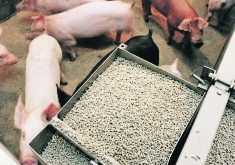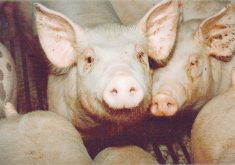Canada has some of the lowest-cost pork in the world, signalling poor returns for hog producers but opportunity to increase exports.
Canada’s hog producers are contending with high feed costs and stagnant domestic pork demand while hog prices are down from last year.
Pork processor Olymel is reorganizing its business, closing slaughter houses in eastern Canada and shutting four hog barns in Alberta and one in Saskatchewan.
American producers are also struggling. Economists at Iowa State University estimate the loss for hogs marketed in April at US$49.47 per head, a record loss for any month and the sixth consecutive month of losses.
Read Also

Working groups established to address challenges in the containerized and bulk movement of commodities
CN is working with the pulse and special crops sector on resolving challenges in shipping those commodities.
It is frustrating that even as the sharp decline in the beef herd pushes beef prices sky high, domestic consumers are not switching to lower priced pork.
The U.S. cutout price for Choice grade beef last week averaged about US$300 per hundredweight, up from about $263 at the same time last year. Meanwhile the pork cutout averaged around $80-$81 per cwt., down from about $107 last year.
A global marketing report from Genesus Genetics, the Canadian-based international seller of purebred swine, on May 24 said the U.S. carcass price worked out to a liveweight price of around 59.5 cents a pound.
The same report said the price in Ontario of a Canadian hog was lower at 52.6 cents per pound. That put it near the bottom of world prices.
The price in southern Brazil was 59 cents and in China it was 91 cents. It was 99 cents in Spain, the United Kingdom and Vietnam. In South Korea it topped $2.
European Union prices this spring are much higher than the usual top of the market, putting pork exporters such as Spain and Denmark at a disadvantage to Canada and the U.S.
Soaring feed and energy prices last year, coupled with strict environmental restrictions, have squeezed EU producers’ incomes, leading to sharp culling of the swine herd, shorting the market of pigs and pushing prices higher. They are also challenged by outbreaks of African swine fever in Central Europe.
The U.S. Department of Agriculture attache unit in The Hague in March estimated the EU’s sow breeding herd Jan. 1 had fallen to 10.38 million, down 4.6 percent from 2022 and down 7.8 percent from 2021.
EU pork exports peaked in 2020 at 5.176 million tonnes, the year of China’s huge imports. The EU had 41.2 percent of global pork trade of 12.56 million tonnes.
EU exports fell sharply since then and are expected at 3.75 million this year, according to USDA figures. That is a 35.5 percent smaller world trade of 10.58 million tonnes, meaning other countries with cheaper pork will likely capture market share.
The USDA thinks Brazil, which has expanded production, will be the main beneficiary, capturing 13.1 percent of world trade, up from 9.4 percent in 2020.
But Canada and the U.S. could also benefit slightly. The USDA forecasts American pork exports could edge up from last year to 2.89 million tonnes, for a market share of 27.4 percent.
The U.S. Meat Export Federation was upbeat in its report of first quarter pork exports. By volume they rose 14 percent over the same period last year.
USMEF president and chief executive Dan Halstrom said “with consumer activity in (Asia) rebounding toward pre-COVID levels and U.S. pork very competitively priced compared to European product, 2023 holds excellent potential for broad-based growth.”
But so far, Canada faces challenges. The USDA forecasts Canadian pork exports at 1.36 million tonnes, down 3.5 percent from 1.41 million last year. Share of the global trade would be 12.8 percent.
That forecast was reinforced by first quarter results that fell almost 10 percent from last year, mainly because of reduced sales to the U.S., Japan and Mexico. However, sales to China rebounded from last year’s poor showing. In its first quarter report, Maple Leaf foods noted that its Brandon processing plant was again approved to ship to China, after being blocked during COVID.
In coming months, pork exports to the U.S., the biggest market for Canada, must negotiate the disruption caused by California’s Proposition 12, the new humane-pork law passed by voters in 2018 that was tied up in the courts until May 11, when the U.S. Supreme Court upheld the law.
It forbids the sale of any uncooked pork from a pig born from a sow that does not have the space to stand up and turn around. This means many farms with existing gestation stalls do not meet the requirements.
There are many uncertainties about the impact of the law and how it could force changes in the U.S. pork supply chain that might affect imports of Canadian pork.














